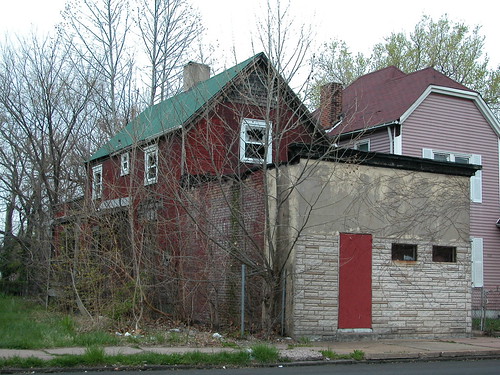 The storefront addition at 4218 Lee Avenue just west of Harris Avenue might be the ugliest one featured in this blog to date. The brick addition, built around 1920, blocks the view of a frame house dating to 1896. Later parging and permastone application don't help matters. Still, the small commercial space created by the addition could be an office, small shop, studio or other use. The house/storefront combination could be made more attractive and the building repurposed as live/work space.
The storefront addition at 4218 Lee Avenue just west of Harris Avenue might be the ugliest one featured in this blog to date. The brick addition, built around 1920, blocks the view of a frame house dating to 1896. Later parging and permastone application don't help matters. Still, the small commercial space created by the addition could be an office, small shop, studio or other use. The house/storefront combination could be made more attractive and the building repurposed as live/work space. The storefront addition at the corner of Penrose and Fair is very discreet, almost blending seamlessly into the four-family dwelling to which it is attached. The storefront dates to 1920, and the parent building to just a few years before then. Thus, the architectural vernacular of the residential building -- since obscured by replacement of the original parapet materials -- was still in vogue when the addition went up, making a harmonious match easy.
The storefront addition at the corner of Penrose and Fair is very discreet, almost blending seamlessly into the four-family dwelling to which it is attached. The storefront dates to 1920, and the parent building to just a few years before then. Thus, the architectural vernacular of the residential building -- since obscured by replacement of the original parapet materials -- was still in vogue when the addition went up, making a harmonious match easy. Again, the modest scale cries out for reuse as the home of a human-scaled enterprise. Located at a fairly busy corner, this could be a sandwich shop, ice cream stand or any number of things.
Again, the modest scale cries out for reuse as the home of a human-scaled enterprise. Located at a fairly busy corner, this could be a sandwich shop, ice cream stand or any number of things.Both of these buildings are owned by the Land Reutilization Authority. There is no coincidence in the fact that both Lee and Fair avenues had streetcar lines in the 20th century; these additions lie near intersections where the cars would have stopped frequently throughout the day. Perhaps these hybrid buildings will be ripe for 21st century commercial revitalization. The streetcars are gone, but the population density of the ward remains high, and the future is looking good.





5 comments:
Hey, your post just made me think of a new slogan for the North Newstead area..
"21st Century in the 21st Ward"
Or maybe not...
How about "21 cool things about the 21st Ward"?
What would that list look like?
Having grown up in the suburbs, I was always jealous of city kids who could walk to a corner store. The main object of walking to the corner store, of course, was to buy penny candy.
I don't think penny candy would sustain a store nowadays.
No, but having kids walking to corner stores can sustain a neighborhood.
What about suburban areas where kids can walk places? What does that do to them?
I grew up in 1970's Glendale-WG-Kirkwood area, and we walked EVERYWHERE. Hell, we'd follow a creek for miles just to see where it went. We'd walk to the Ben Franklin in Warson Woods, ride our bikes to parks, and around the trails of a small wooded plot. Needless to say, there wasn't a fatty in the bunch. Parents weren't chauffers back then. Well, OUR parents weren't chauffers. The only times they drove was when we wanted to go to a movie: Lindbergh, Creve Ceour (sp), a couple of others. Or maybe ice skating in Kirkwood, or Shakey's Pizza on Watson. Tho' that was more of a family outing. Mmmm, huge 18" pizza with root beer, and I seem to recall ragtime being played on the piano, tho' I also remember a player piano and the reels stacked on top. Not a bad suburban upbringing, for the most part. However, I don't think that kind of suburbia exists anymore.
That was back in the days when Pizza Hut was still in the 'hut', and now you see what 'huts' remain being adaptively reused as flower shops and such... We lived for a short period of time in Chigago Heights, Illinois, and I recall buying the candy bottle caps at a penny candy window not unlike the bump-out, lean-to additions often seen on older frame homes built a century ago. Live-work arrangements would allow much light, walk-up trade to take place in a neighborhood setting, however most live-works are not of a retail nature. In struggling neighborhoods where threats of robbery are at least perceived to be high, the risk could be beyond the willingness of the adventurous.
Post a Comment